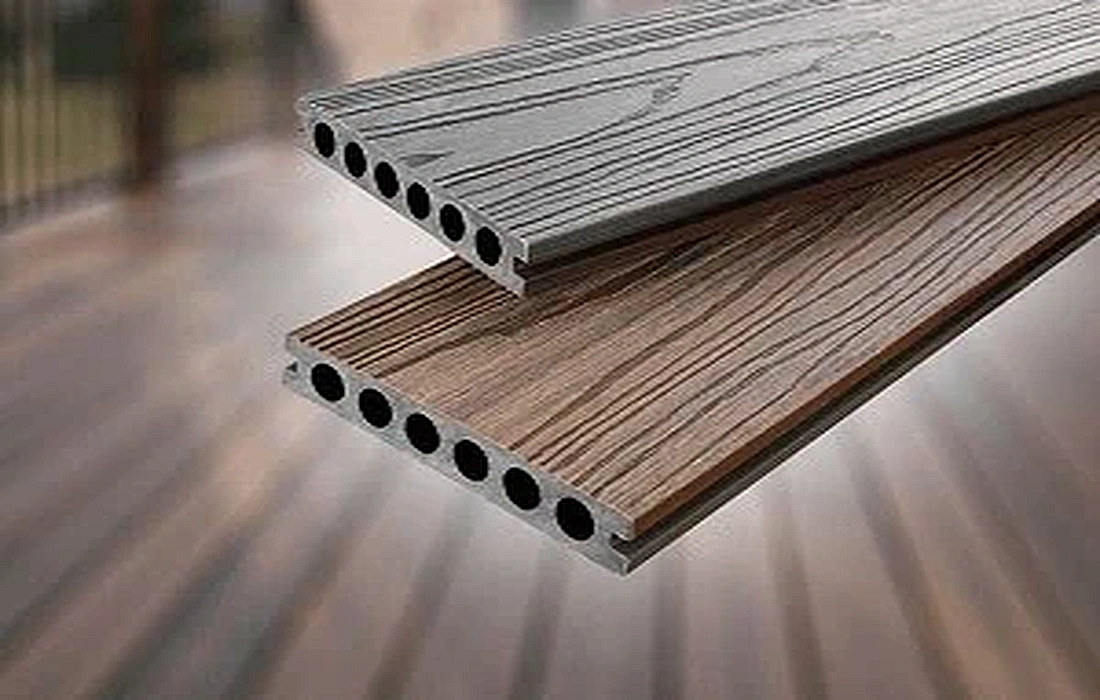Wood plastic, as a modern composite of wood powder and polymer, provides an intelligent solution for replacing natural wood and thermo-wood in outdoor areas. This material, resembling wood but more durable, has become a useful option in designfor flooring, facades, and poolside woodtransforming into. Its resistance to moisture, temperature fluctuations, and insects, along withits various sizes of wood plastic, and featureswater-resistantare among the reasons why it is loved by designers. Next, more abouttypes ofwood plastic, its advantages,disadvantages of wood plasticand its diverse applications will be explored.
What is wood plastic?
Wood plastic, or WPC, is one of the innovative products in the composite material family, produced by combining wood powder with industrial polymers. This material is shaped in varioussizes of wood plasticthrough extrusion and is used in various construction and outdoor projects.
The composite structure of wood plastic makes it resemble natural wood in appearance while offering superior technical qualities. Key advantages of wood plastic include saving raw wood, preventing illegal deforestation, and reducing environmental waste. It is also widely used to make products such aswood plastic flooring,wood plastic facades, flower pots, benches, and outdoor furniture.
High resistance to UV rays from the sun, ability to withstand harsh weather conditions, and especiallywater resistancehave made wood plastic a popular choice in humid, coastal, and even around pool areas. For this reason,wood plastic around poolsis one of the most used options in outdoor design.
Wood plastic or thermo-wood; which is the better choice?
For external design such as facades, flooring, gazebos, orpoolside wood, choosing durable and strong materials plays a key role. The two common options for these uses are,thermo-woodandwood plasticeach with their own features and limitations.
Thermo-wood is a type of natural wood treated through a high-temperature heating process that modifies its cellular structure, increasing its resistance compared to raw wood. This process makes thermo-wood more resistant to moisture, decay, and temperature changes. However, thermo-wood remains an organic material and requires maintenance such as oiling, staining, and regular protection against fungi, mold, and insects to maintain its appearance and performance.On the other hand,
wood plasticas an advanced composite, combines wood powder and industrial polymers to provide a more stable and resistant mechanical and chemical properties. This material naturally resists moisture, algae, fungi, and insect attacks, requiring no annual maintenance. Moreover, wood plastic does not significantly change color when exposed to direct sunlight and performs well under UV rays.From an economic perspective,wood plasticwith its higher durability, lack of need for periodic repairs, various sizes, and long lifespan, proves to be more economical than thermo-wood in the long run. Additionally, its ability to be produced in different colors and designs allows architects to create diverse aesthetic spaces.
wood plasticvsthermo-woodfeatures✔
| ✖ | High resistance to moisture | ✔ |
| ✖ | Resistant to mold and algae | ✔ |
| ✖ | Resistant to insects and termites | ✔ |
| ✖ | Resistant to UV rays | ✔ |
| ✖ | No need for periodic maintenance | ✖ |
| ✔ | Need for staining and oiling | ✔ |
| ✖ | Variety of colors and sizes of wood plastic | ✖ (resembles natural wood) |
| ✔ (natural wood) | Feeling and natural texture of wood | ✔ |
| ✔ | Compatibility with the environment | ✔ |
| ✖ | Long lifespan in outdoor environments | ✔ |
| ✖ | Cost-effective in the long term | Application of wood plastic in outdoor design |
| Wood plastic plays an important role in modern outdoor design as a mixed material. Among its many uses, it is most popular for | wood plastic flooring | in outdoor settings. This material, with its non-slip surface, |
high water resistance
and anti-algae properties, is a reliable choice for pathways, terraces, rooftop gardens, and patios.One of the most common uses is installingwood plastic around poolswith features such asnon-slip, resistance to pool chlorinated water, and waterproofing of wood plastic
, providing excellent performance in humid conditions. Unlike natural woods, which tend to swell, crack, or decay when wet, wood plastic maintains a stable structure and longer lifespan, reducing maintenance costs over time.Besides flooring,wood plastic facadesare also used in exterior designs of villas, commercial centers, and modern buildings. Its similar appearance to wood, diverse color options,and easy installation have made it a preferred material among architects and designers. Wood plastic resists UV rays and weather conditions well and does not significantly change color or quality over time.
Review of available sizes and shapes of wood plasticOne of the key advantages ofwood plasticis the variety in its sizes and shapes. This feature allows it to be used for a wide range of applications in construction and outdoor projects. Depending on the use, lightweight hollow profiles can be used forwood plastic facades
or fencing, while thick, strong boards are suitable for high-traffic flooring.
Dimensions of wood plasticare designed to meet different operational needs. Profile widths typically range between 12 to 20 centimeters, and thicknesses can be from 20 to 50 millimeters, selected based on use. Profiles are usually 3 to 6 meters long, with options forcustom sizingbased on project requirements.Shape and size variety offers flexibility in design, allowing architects and contractors to use wood plastic in floors, exterior facades, handrails, fences, flower pots, or even light structures. This versatility makes
wood plastica multifunctional and highly practical choice in modern architecture.Types of wood plastic based on applicationDepending on their internal structure, resistance levels, and surface design, wood plastics are classified into different types. This diversity ensures optimal selection for various project needs, guaranteeing performance, durability, and aesthetic appeal.
1. Hollow wood plasticHollow wood plasticDue to its lightweight construction and material efficiency, it is suitable for projects with low mechanical stress. This profile type is typically used for
fences, flower pots, decorative elements, canopies, and side claddings.
Its reduced weight allows easier transport and faster installation, making it more cost-effective.
2. Solid wood plastic
Solid wood plastichas a higher density and greater strength, making it ideal for high-traffic areas. This profile type is widely used in:flooring for terraces, roof gardens, pool surroundings, and public spaces, with excellent resistance to impact, pressure, and moisture.Range of surface textures and applications of wood plastic
Besides internal structure, the external surface of
wood plasticalso plays a critical role in design, safety, and environmental compatibility. Various surface types include:Smooth surfaceThis type offers a uniform and minimal appearance, suitable for modern spaces, building facades, or
wood plastic facades
and is easy to clean. However, it is not recommended for humid or high-traffic areas.Grooved surfaceGrooved wood plastic
increases traction and creates slip-resistant properties. This design is often used for
poolside, entryways, and walkways. The grooves also help prevent water accumulation.Banded textured surfaceThis textured finish resembles natural wood grain. It is suitable for those wanting a natural aesthetic with high durability, used in facades, villa decorations, rooftop gardens, and commercial spaces.
Advantages and disadvantages of wood plastic
Due to its unique features, wood plastic has broad applications in outdoor and facade design, but like any product, it has limitations that are important to understand for better choices.Advantages of wood plasticThis material shows high resistance to water penetration, insect attack, and corrosion, reducing the need for frequent repairs. Unlike natural wood and thermo-wood,wood plasticdoes not require periodic painting or staining, which lowers maintenance costs. Additionally, it offers a wide range of color options and sizes, allowing customization to diverse architectural designs.Fast and easy installation is another benefit, speeding up project completion. Its anti-slip surface makes it safe for wet environments like around pools and in humid conditions.
Disadvantages of wood plastic
Initial costs are higher than raw wood, which can influence project budgets. Although resistant to sunlight, slight color changes may occur over time, usually stabilizing later. Also, its higher thermal conductivity compared to natural wood can cause the surface to become warmer in direct sunlight, which should be considered during design.Waterproof wood plastic; a suitable choice for humid environmentsOne of the standout features of
wood plastic
is its water resistance, enabling its use in humid environments. Thanks to the unique combination of wood powder and industrial polymers, moisture absorption is minimized, reducing swelling, cracking, or rotting.
This makes wood plastic an ideal option for spaces like saunas, jacuzzis, pool surrounds, or even balconies and gardens. In such areas, its resistance
and durability help preserve appearance and longevity.Especially in humid or seaside locations where natural wood is prone to damage from moisture and weather, wood plastic performs better and lasts longer. Therefore, using this material in such environments is highly recommended for cost-effective, durable outdoor solutions.DenizWood; Leading Provider of Custom Wood Plastic and Outdoor DecorDenizWood has many years of experience in designing and implementing interior and exterior decor. It is one of Iran’s most trusted direct suppliers of facade wood, Finnish thermo-wood profiles, and wood plastic. Besides manufacturing various profiles, this specialized company offers professional services for building facades, green roofs, wooden elements such as gazebos and pergolas, as well as outdoor environment beautification and landscaping.Using advanced machinery and a team of expert engineers, DenizWood produces high-quality, export-ready products in a wide range of colors and long-lasting materials to meet construction, villa, and landscape project needs. Professional installation, precise execution, and ongoing support ensure customer satisfaction.
To learn more about their diverse products and view completed projects, visit the official website denizwood.com and benefit from expert consulting services.
Conclusion
Wood plastic, which beautifully mimics wood but offers greater longevity, is a durable, low-maintenance alternative to natural wood and thermo-wood, widely used in facade and outdoor projects. Its high resistance to moisture, UV rays, insects, and decay, along with color and size variety, makes it suitable for flooring, facades, and around pool areas. Although initial costs are higher, its reduced maintenance needs make it an economical choice. DenizWood’s quality products and professional installation services make it a reliable option for construction and landscape projects.
https://www.denizwood.com/
Contact number: 09392626066
Wood Plastic; A Modern Composite for Beauty and Durability in Outdoor Design








